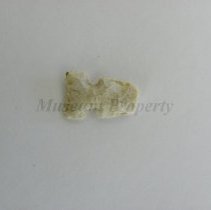Object Record
Images

Metadata
Object Name |
Arrowhead |
Source |
O'Brien County Conservation Board |
Iowa History Era Tag |
First Iowans (10,000 BCE-1673) |
Chronological Tag |
Three Worlds Meet (Beginning to 1620) |
Catalog Number |
2018.039.003 |
Credit line |
O'Brien County Conservation Board - Peterson, Iowa |
Description |
The "bird point" arrowhead dates back to the Oneota era. The term "Oneota" referred to the Oneota River, now called the Upper Iowa River, where many Native American artifacts were found. Oneota artifacts have been found across the state; however, the Oneota people are usually associated with the Mississippi Valley. Historical evidence suggests that the Oneota people later became the Otoe, Ioway and Missouria tribes. The term "bird point" used to describe arrowheads of this type has suggested that Natives used them to hunt birds; however, these arrowheads have also been found near the remains of larger game, such as elk and bison. Content can be used with the following standard: 1st grade SS 1.23 Cultural Makeup in a lesson on Native Americans of Iowa and the tools they commonly used in survival. For any use other than instructional resources, please check with the organization that owns this item regarding copyright restrictions. |
Additional Research & Sources |
The term "Oneota" used as an archaelogical term was coined by Charles Keyes in the early 1900s when describing ceramic pottery found in Northeastern Iowa by Ellison Orr. The term is also used to refer to the group of people who resided in the area during the period of A.D. 1000-A.D. 1650. In addition to pottery decorated with a chevron pattern, bone tools were also commonly used within the Oneota tribe such as bone hoes and sickles, bone pipes, scrapers, mauls and triangle arrow heads as pictured. It is unknown where the Oneotas originated from, however some researchers have said the group may have migrated from the present day location of East St. Louis, Illnois. The Oneota tribe survived on a plant and meat based diet, consisting of food such as squash, beans, corn, bison, deer, elk and several varieties of bird and fish. Arrowheads would have been used to kill animals (attached to a long stick and used in a bow and arrow manner) such as when the tribe went on seasonal bison hunts twice a year. |
Notes on Related Objects |
Object is related to the following library resources, which can be found by searching the catalog number in the advanced search section: Catalog #: 2018.045.032 The Worlds Between Two Rivers: Perspectives on American Indians in Iowa 2018.045.033 Inkpaduta: Dakota Leader 2018.045.034 Meskwaki History 2018.045.052- Iowa: Its History and Its Foremost Citizens 2018.045.072- The Story of Iowa: A Children's History 2018.045.075- One Hundred Topics in Iowa History 2018.045.083- A History of the People of Iowa 2018.045.078 The Middle West in American History 2018.045.085 I am a man; the Indian Black Hawk 2018.045.087- Iowa Through the Years 2018.045.113- Bison Hunters of the Western Prairies: Archaeological Investigations at the Dixon Site 2018.045.116- The Indians of Iowa 2018.045.129- Still Running: A Tribute to Maria Pearson, Yankton Sioux 2018.045.138- History of Iowa from the Earliest Times to the Beginning of the Twentieth Century 2018.045.184- Iowa: The Pioneer Heritage 2018.045.143- Iowa Inside Out 2018.045.198- Mississippi River 2018.045.204- The Black Hawk War of 1832 2018.045.208- Prehistoric Indians of Iowa 2018.045.225- Effigy Mounds 2018.045.226- Ioway Native Americans 2018.045.227- Meskwaki Native Americans 2018.045.228- Toolesboro Mounds |
Primary/Secondary Source |
Significant - State/National |
Multimedia Links |
Click here to view/hear the file. |
Search Terms |
Ancient Iowans Native Americans Plants & Animals Oneota Culture Arrowheads Upper Iowa River Archaeology |
Legal Status |
Ownership of this resource is held by the O'Brien County Conservation Board and has been provided here for educational purposes only, specifically for use in the Iowa Museum Association's "Teaching Iowa History" project. It may not be downloaded, reproduced or distributed in any format without written permission from the Rights Holder. For information on U.S. and International copyright laws, consult an attorney. |
